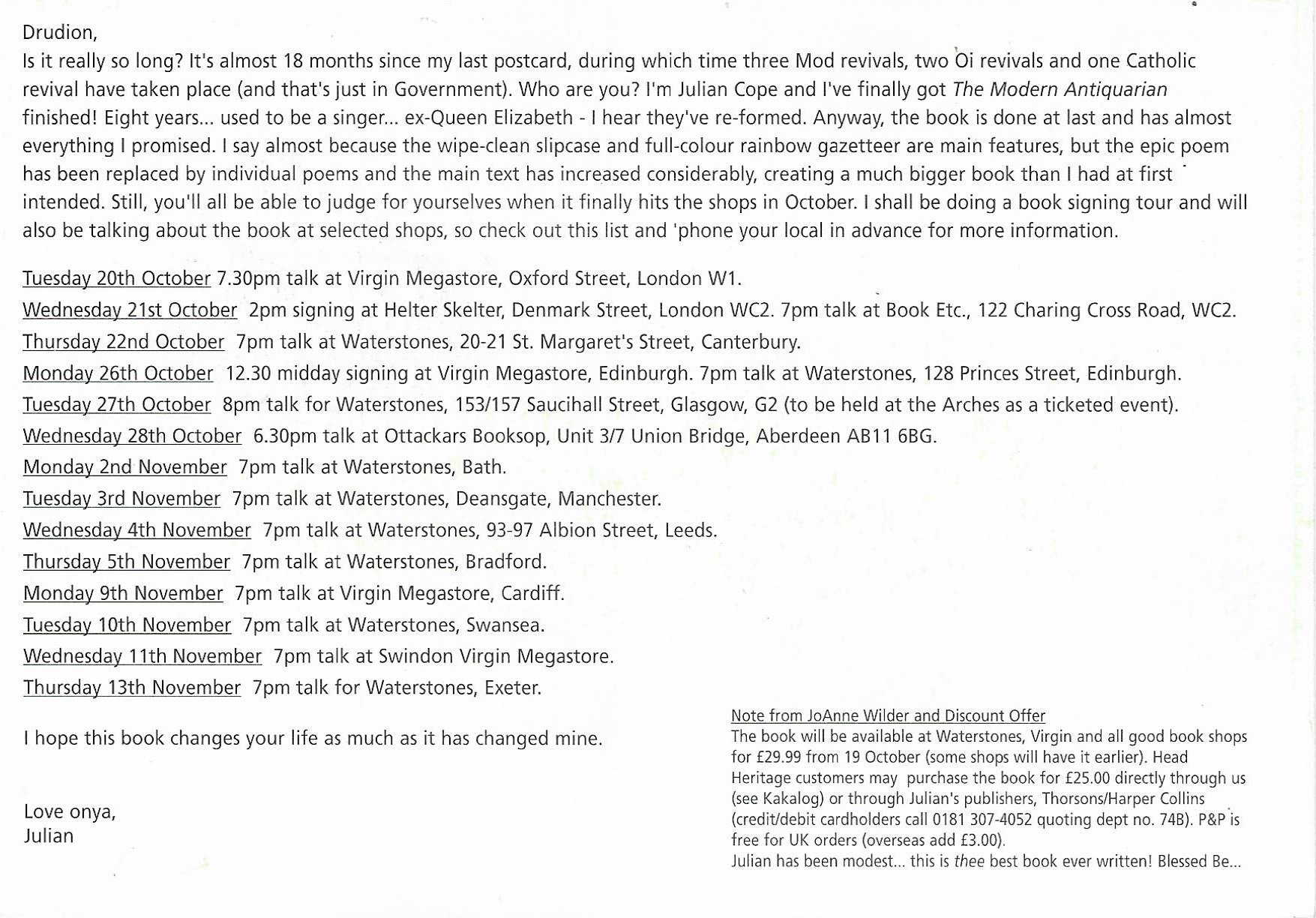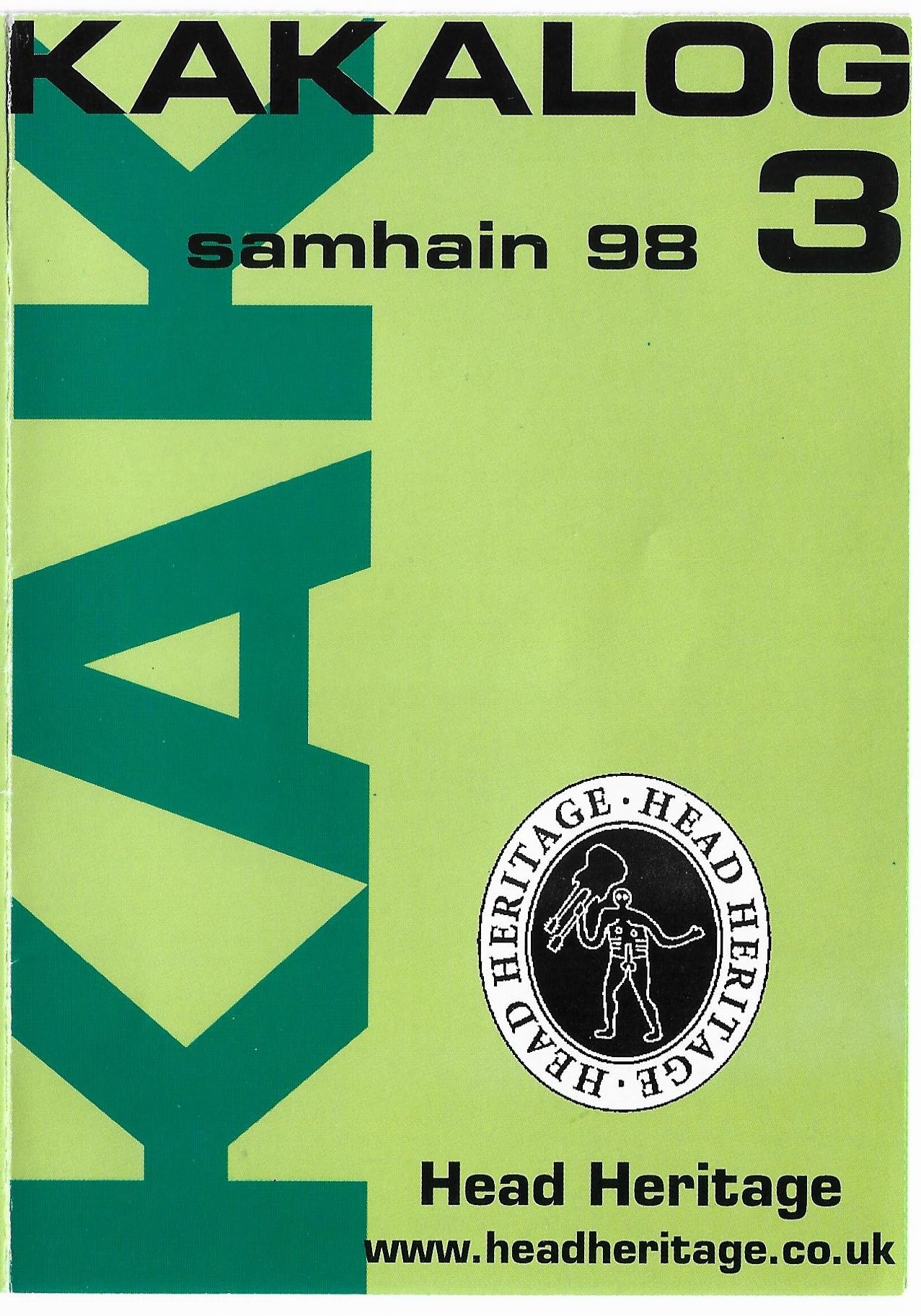Julian Cope’s Postcards
Julian Cope’s Postcards taking in: Krautrocksampler, Cope’s Notes, Julian Cope and Donald Ross Skinner’s Rite, Faith magazine, 1993’s The Acoustic Tour, bootleg tapes, John Cooper Clarke, The Modern Antiquarian, Royal Kilmainham Hospital, Vinyl Dublin, stone circles, Gaulstown Dolmen and The Heavy Camel Corps of the Sudan campaign of 1885.
There are only a handful of artists that I’ve stayed the course with; Julian Cope is one of them. I’ve been a fan for a long time - The Teardrop Explodes are one of my favourite bands. I discovered them in the mid-80s along with Echo & the Bunnymen and worked my way back. Like many people my age, it was the singles from 1987’s Saint Julian (‘World Shut Your Mouth’ and ‘Trampolene’) that introduced me to Cope’s solo work. Staying the course with Cope has been a trip.
Cope’s still releasing great records; and his books have been an education - inspiring me to explore new music that I otherwise would never have been introduced to. I’ve often joked that Krautrocksampler may have only cost a few punts in 1995, but over the years it has cost me a fortune in vinyl. It’s not a joke!
The Megalithic European: The 21st Century Traveller in Prehistoric Europe (2004)
One Three One (2014)
Repossessed: Shamanic Depressions in Tamworth & London (1983–89) (1999)
Japrocksampler: How the Post-war Japanese Blew Their Minds on Rock 'n' Roll (2007)
Head-on: Memories of the Liverpool Punk Scene and the Story of The Teardrop Explodes, 1976–82 (1994)
Krautrocksampler: One Head’s Guide to the Great Kosmische Musik – 1968 Onwards (1995)
Photograph by Paul McDermott
It’s impossible to pick my favourite Cope album, but his trio of albums in the early 90s - Peggy Suicide (1991), Jehovahkill (1992) and Autogeddon (1994) - are high points in a long career. In recent years he has released a series of beautifully designed A5 books with cover mounted CDs looking back at specific projects and periods. Like all of his output the attention to detail with these releases is incredible.
The SydArthur Festival (2017) and Cope’s Notes #1-#5. Photograph by Paul McDermott.
In 1992 an American named Leigh Baker arrived in Cork (like a hurricane). She published Faith magazine and over the course of three exciting issues gave countless Irish bands their first press coverage: reviews, news, features and cover stories. Leigh sadly passed away in 2015.
She published my first review. In February 1993 Julian Cope and Donald Ross Skinner released Rite - a long instrumental album of Krautrock and psychedelic influenced jams. In the second issue of Faith (May 1993) myself and my old pal Paul Cussen (Paul of the Brendan Behan t-shirt story, as mentioned in my last post: Sonic Youth and Nirvana - Sir Henrys 1991) reviewed the album and thanks to Stephen Rennicks of Abstract Analogue, I can reproduce the review here:
Rite by Julian Cope and Donald Ross Skinner. Faith #2 (May 1993). Reviewed by Paul McDermott and Paul Cussen. Scanned by Stephen Rennicks.
It’s slightly embarrassing reading something back that was written over 30 years ago but it serves a purpose here - in the last paragraph we mention that Cope was planning a Cork gig in July 1993. That gig did happen - indeed Cope’s “The Acoustic Tour” saw him announce four solo performances in Irish Castles in Cork, Belfast, Dublin and Galway.
I couldn’t believe it, I was off to the USA on a J1 working visa for the Summer so I was going to miss the Cork gig. Paul came to my rescue and bootlegged the Blackrock Castle gig and posted the tape over to the States for me - what a legend. I know I have another Cussen bootleg tape somewhere in my house - a live recording of John Cooper Clarke in Cork’s Lobby Bar from the early 90s. I haven’t heard the tape in 30 years but I can still hear Clarke pleading with the crowd to: “human chain a half-Beamish to me now.”
Julian Cope - Acoustic Tour, Blackrock Castle - 01 July, 1993 CE. Photograph by Paul McDermott
I returned from Boston and couldn’t believe my luck - the Dublin leg of the tour at Royal Hospital Kilmainham had been cancelled and I was able to attend the rescheduled date. Score!
The gig took place in the Great Hall of Royal Hospital Kilmainham. It was a brilliant night. I got to meet Cope after the gig, I can’t remember the details exactly but I think we may have sent him the Rite review. He brought me in backstage and presented me with a vinyl copy of The Skellington Chronicles autographing the inner sleeve. A Treasure.
It would be a quarter of century before I would set foot in RHK’s Great Hall again. This time it was for a series of talks organised by Vinyl Dublin. Tracey Thorn, Cosey Fanni Tutti, Can’s Irmin Schmitt, Kevin Shields, Bella Union’s Simon Raymonde were all exceptional in May 2018, but the highlight of the weekend for me was discovering a small plaque on the wall between The Baroque Room and The Great Hall.
Can’s Irmin Schmidt in conversation with Rob Young at Vinyl Dublin (06 May 2018). Photograph by Paul McDermott.
The plaque is dedicated to the Officers, Non-Commissioned Officers and Men of the 16th Lancers who lost their lives while serving with the “The Heavy Camel Corps” in the Sudan between 1884-85.
The Four Feathers was one of my favourite Saturday matinee films growing up and I couldn’t believe that I was sitting next to a plaque that remembered fallen soldiers who fought in the actual battle depicted in the film. Vinyl be damned!
Photograph by Paul McDermott.
Julian Cope took control of his career once he was dropped by Island Records. He started releasing albums on his own label and if you purchased something from him you were added to his mailing list.
In the 90s loads of bands included mailing list postcards with their records. You could affix a stamp and post off the postcard - usually to the same address in Leamington Spa, presumably to a company that got the outsourced gig from the labels. This was direct marketing from artist to fan, pre-Internet, pre-email. Nine times out of ten you never heard from the band or record label again.
Cope was different.
The first postcard arrived in June 1994, a few months before the release of Autogeddon and they continued up to October 1998 with the publication of The Modern Antiquarian.
In total I have nine postcards, there may have been more posted out but in the 90s I lived at a variety of addresses across Cork city and I wouldn’t be surprised if a few postcards went astray. Each postcard has a beautiful photograph of a stone circle or megalithic monument and the text details Cope’s various activities throughout the mid 90s, particularly the research and writing for his travelogue of British megalithic sites: The Modern Antiquarian.
On the second postcard, in November 1994, Cope writes: “I’m currently writing a short book called Krautrocksampler, a guide to the most over the top hippy/punk music of all - Faust, Can, Ash Ra Tempel, Neu! and all that stuff.” I had heard of Can but not the others. I can remember getting excited and duly purchasing Krautrocksampler when it was published the following year - I’m glad I did because the book became an incredible educational resource and informed my record buying purchases for years.
In July 1995 a postcard brought news of the ‘Try, Try, Try’ single and the 20 Mothers album. On a postcard from August 1995, Cope wrote about performing ‘Try, Try, Try’ on Top of the Pops, “I teetered & tottered around like a man possessed whilst Moon-eye wore wraparound pink plastic over his face.” In June 1996 he wrote about his next single - ‘I Come From Another Planet Baby’ - and news that work on The Modern Antiquarian was continuing.
In July 1996 he wrote about the Sex Pistols reunion: “I briefly considered stopping the Sex Pistols comeback with telephoned death threats to Glen Matlock as Son of Sid, but decided that Rotten’s punishment is already enough, he has to Hang-out (sick) with those guys for the coming months.” A postcard from September 1996 brought news of the ‘Planetary Sit-In’ single and had a beautiful photograph of Derrentaggart stone circle a few miles from Castletownbere in Co. Cork. This was a stone circle I had visited so I was particularly excited about this postcard.
A postcard from October 1996 mentioned Cope’s next album, Interpreter and news that The Modern Anitquarian was nearing completion.
The last postcard I have announces the publication of The Modern Antiquarian and a corresponding book tour in October 1998. headheritage.co.uk had came online in 1997 so there was no more need for the postcards. Cope’s monthly Address Drudion columns and his record reviews became essential reading for the next two decades.
I didn’t buy The Modern Antiquarian - it’s cover price was beyond my means in 1998, like Krautrocksampler it goes for stupid money. I wish now that I had picked it up. It’s follow-up, The Megalithic European, was published in 2004. I was lucky enough to find a secondhand copy of it in Oxfam about 15 years ago for a bargain price of €10. It’s got a whole section on the megalithic sites of Cork:
“There is such a surplus of megalithic riches strew around Cork and the Kerry borderland that even ardent explorer’s on a month’s holidays would be hard pressed to put a dent in their wish-list of sites to visit.”
Julian Cope, The Megalithic European
I got to see Cope once more in 2002, another great show.
Gaulstown Dolmen, Co. Waterford. Photograph by Paul McDermott.
I’ve a lot to thank Cope for. All the great music he’s introduced me to over the years and an interest in our own megalith monuments. It’s been a trip. Julian Cope’s postcards are reproduced below.
Maeshowe, Mainland Orkney, Scotland. Photo by Julian Cope.

































